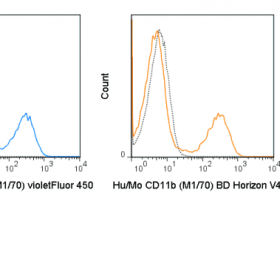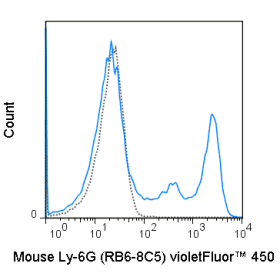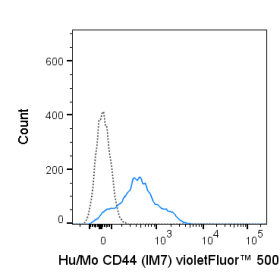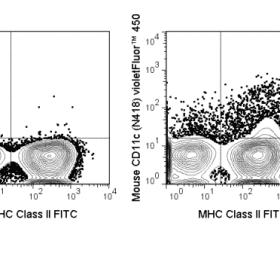Product Description
| Cat No. | Size | Price |
|---|---|---|
| 75-0038-T025 | 25 tests | $57.00 |
| 75-0038-T100 | 100 tests | $126.00 |
Description
The UCHT1 antibody is specific for human CD3e, also known as CD3 epsilon, a 20 kDa subunit of the T cell receptor complex, along with CD3 gamma and CD3 delta. These integral membrane protein chains assemble with additional chains of the T cell receptor (TCR), as well as CD3 zeta chain, to form the T cell receptor – CD3 complex. Together with co-receptors CD4 or CD8, the complex serves to recognize antigens bound to MHC molecules on antigen-presenting cells. These interactions promote T cell receptor signaling (T cell activation), inducing cell proliferation, differentiation, production of cytokines or activation-induced cell death. CD3 is differentially expressed during thymocyte-to-T cell development and on all mature T cells.
The UCHT1 antibody is a widely used phenotypic marker for human T cells. In addition, binding/cross-linking of UCHT1 antibody to CD3e can induce cell activation (use format suitable for functional assays). A recent publication of the crystal structure of a CD3e- antibody complex provides insight as to the action of commonly used agonist antibodies, as well as specific epitope-binding data for the human CD3 antibodies UCHT1 and OKT3 (Fernandes, R.A. et al. 2012. J. Biol. Chem. 287: 13324-13335).
UCHT1 antibody reacts with both surface-expressed and intracellular CD3e protein, in contrast to an alternative human CD3 clone, HIT3a, which will stain only the extracellular (membrane-expressed) CD3e protein. Also, the UCHT1 antibody is reported to be cross-reactive with chimpanzee and has been used for phenotypic analysis of expression by flow cytometry; however the antibody is reported to be unsuitable for induction of T cell activation in this species (Bibollet-Ruche et al. 2009. J. Virol. 82: 10271-10278).
Product Details
| Name | violetFluor™ 450 Anti-Human CD3 (UCHT1) |
|---|---|
| Cat. No. | 75-0038 |
| Alternative Names | Leu-4, T3 |
| Gene ID | 915 |
| Clone | UCHT1 |
| Isotype | Mouse IgG1, kappa |
| Reactivity | Human |
| Cross Reactivity | Chimpanzee |
| Format | violetFluor™ 450 |
| Application | Flow Cytometry |
| Citations* | Harris SJ, Parry RV, Foster JG, Blunt MD, Wang A, Marelli-Berg F, Westwick J, and Ward SG. Apr. 2011. J. Immunol. 186: 4936-4945. (in vitro activation)
Beriou G, Bradshaw EM, Lozano E, Costantino CM, Hastings WD, Orban T, Elyaman W, Khoury SJ, Kuchroo VK, Baecher-Allan C, and Hafler DA. 2010. J. Immunol. 185: 46-54. (in vitro activation) Soto PC, Stein LL, Hurtado-Ziola N, Hedrick SM, and Varki A. 2010. J. Immunol. 184: 4185-4195. (Flow cytometry – Chimpanzee) Edelbauer M, Datta D, Vos IHC, Basu A, Stack MP, Reinders MEJ, Sho M, Calzadilla K, Ganze P, and Briscoe DM. 2010. Blood. 116:1980-1989. (Immunohistochemistry – acetone fixed, frozen sections; Immunofluoresence microscopy) Varghese JC and Kane KP. 2008. J. Immunol. 181: 6002-6009. (in vitro activation) Mack CL, Tucker RM, Sokol RJ, Darrer FM, Kotzin BL, Whitington PF and Miller SD. 2004. Pediatr. Res. 56(1):79-87. (Immunohistochemistry – frozen tissue) Sakkas LI, Scanzello C, Johanson N, Burkholder J, Mitra A, Salgame P, Katsetos CD, and Platsoucas CD. 1998. Clin. Diagn. Lab. Immun. 5:430. (Immunohistochemistry – acetone fixed, frozen sections) Salmeron A, Sanchez-Madrid F, Ursa MA, Fresno M, and Alarcon B. 1991. J. Immunol. 147:3047-3052. (Immunoprecipitation) Van Dongen JJ, Krissansen GW, Wolvers-Tettero IL, Comans-Bitter WM, Adriaansen HJ, Hooijkaas H, van Wering ER, and Terhorst C. 1988. Blood. 71: 603-612. (Western Blot) |
Application Key:FC = Flow Cytometry; FA = Functional Assays; ELISA = Enzyme-Linked Immunosorbent Assay; ICC = Immunocytochemistry; IF = Immunofluorescence Microscopy; IHC = Immunohistochemistry; IHC-F = Immunohistochemistry, Frozen Tissue; IHC-P = Immunohistochemistry, Paraffin-Embedded Tissue; IP = Immunoprecipitation; WB = Western Blot; EM = Electron Microscopy
*Tonbo Biosciences tests all antibodies by flow cytometry. Citations are provided as a resource for additional applications that have not been validated by Tonbo Biosciences. Please choose the appropriate format for each application and consult the Materials and Methods section for additional details about the use of any product in these publications.
.
[accordions]
[accordion title=”Protocols”]Technical Date Sheet[/accordion]













